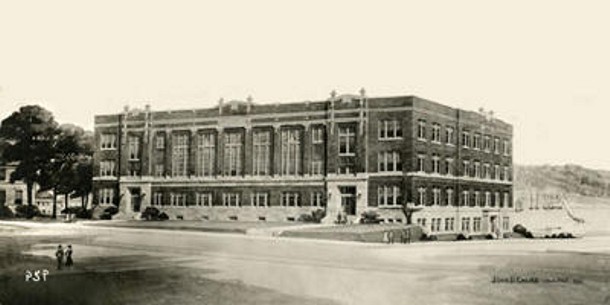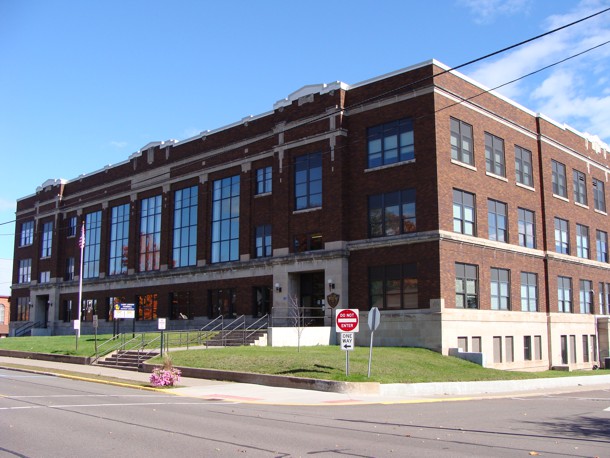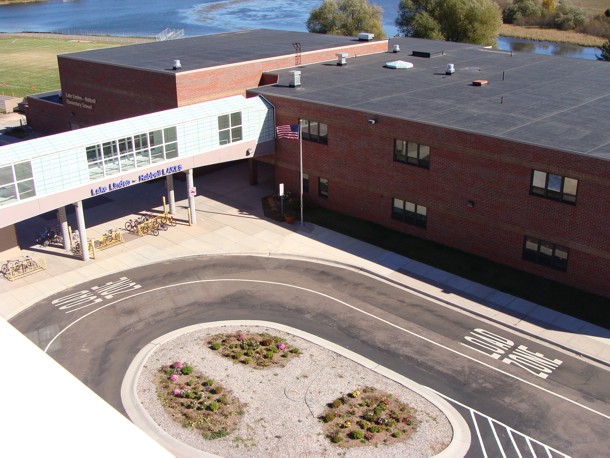|
Story of the Washington (Lake
Linden-Hubbell) High School
Alfred and James Beesley
arrived at the head of the Torch Lake about two
years after the settlement, later to be called
Lake Linden, was established. Alfred Beesley
built the first house in the area, which was
later used as a one-room schoolhouse with Miss
Seeley as the teacher.
The first one-room school
building was erected in 1867 and used by all
denominations for church services and for all
town meetings and entertainment. Two additions
were added with funding for the first from
taxation and the second by Calumet and Hecla
Mining Company.

The first teacher on
record is a Miss Kate Quinn, who was hired to
teach "Primary District #1, Schoolcraft Township
for the term of nine months, commencing on the
first day of November , 1869." Miss Quinn was
seventeen years old when she was hired to teach
in Lake Linden and was paid $450 for her nine
month teaching contract. In addition to her
teaching salary, she was paid five dollars per
month to attend to daily sweeping and making or
starting a fire.
The school building cost
about $2,000 but was destroyed by fire in
November of 1881. It was rebuilt the same year
at a cost of $15,000 by the Calumet and Hecla
Copper Mining Company on the site occupied by
the present high school building, and leased to
the school district at a nominal sum. The
fixtures in the building cost $4,000.
The influx of children
into the area was quite rapid and the schools
expanded to meet the demands of the growing
population. By 1872, a male teacher and female
teacher were hired and two years later, the
school had a staff of three, a male teacher as
principal and two female assistants. In 1875,
there were enough students to warrant a form of
departmentalization: Mr. William Bath, the
principal; Miss Daily and Miss Gilbert, primary
teachers; Miss J. Johns, intermediate department
and Miss B. Widner, preceptress and teacher of
music, both vocal and instrumental.
In 1883, there were seven
hundred and fifty-four pupils of school age with
an attendance of six hundred in thirteen
departments served by thirteen teachers; the
directors of the school were authorized to
establish a high school, so the building was
rearranged to provide suitable facilities for
use as a high school as well as a grade school.
Two years later, in 1885,
the first class was graduated. The all-girl
class consisted of Belle McIntyre, Anna Pauline,
Maggie Lamont, Mary Sullivan, Clara Schlichting,
Sarah Lamond, Sarah Kaufman and Bertha
Schlichting. The first male student to graduate
was Samuel Eddy in a class of four pupils in
1886.
Starting in July of 1887,
many changes were made in the Lake
Linden-Hubbell school building. The Calumet and
Hecla Company, who owned the property, put in a
new entrance to the hall from Calumet Street and
another stairway from the second story, thus
rendering escape from the building in case of
fire or a panic from any cause. In addition to
this, the school board had all the exit doors
changed so as to open out - in accordance with
the State law and all of the rooms re-plastered.
After a quarter of a
century of use, the school building was sadly
outgrown. The number of Lake Linden and Hubbell
children had been steadily increasing since the
first high school classes had been offered in
1883. In addition, St. Ann's Academy was to
discontinue high school instruction with the
June 1915 graduation ceremonies. This would add
fifty or more students a year to the public
school enrollment.

At a special meeting held
on June 21, 1915, the Lake Linden-Hubbell School
Board resolved: "....whereas this Board has
investigated and considered the question of the
inadequacy and insufficiency of the present
Central High School Building for the purpose of
accommodating in a suitable, sanitary, and
proper manner for the pupils of this District,
and have found and determined that such
buildings are altogether inadequate,
insufficient, unsafe and unsanitary and that the
proper housing, the health and educational
requirements of the present High School Building
are altogether insufficient for these purposes
and that the erection of a new complete,
sanitary and up-to-date Central High School
Building is necessary;...."
A special election was
called to decide whether the School Board would
be authorized to issue bonds and borrow money
"for the purpose of erecting and furnishing a
new Central High School Building." After eighty
persons had cast their ballots, the Election
Board discovered that the amount of proposed
bond did not appear on the ballot. If the
proposal on the ballot passed, a second election
would have to be held to set the amount of
indebtedness that the School Board could incur.
Following a consultation
with the Prosecuting Attorney, the Election
Board decided to ask the people who had already
voted to return to the city hall and vote again
on correct ballots. All eighty voters returned
and "voted the corrected ballots with the other
voters." A total of one hundred and fifty
ballots were cast, one hundred and thirty-nine
in favor of bonding the school district for
$100,000 to build a new school, ten against and
one not voting.
Bonds, which were to run
for fifteen years, were sold and the rate of
interest was four and one-half percent, with
payments scheduled to be made beginning in 1920
and extending through 1929.
Before construction could
begin, two major problems had to be considered.
First, the property on which the old building
stood, as well as the building itself, belonged
to the Calumet and Hecla Mining Company. The
site problem was solved when C&H agreed to give
the school a ninety-nine year lease on the
property.
The second problem was
more difficult. It was necessary to provide a
place for the children to attend school during
the period when the new building was being
constructed. Since the same site was to be used,
temporary facilities elsewhere had to be found
or the old building had to be moved to a
different site.
Within a week of the July
1st election, the School Board advertised for
bids "to move the Washington School Building
from its present location across Front Street to
near the shore of Torch Lake." Two bids were
received and the contract was awarded to the
Edward Ulseth Company of Calumet who agreed to
move the school for $6,325.

Mr. Ulseth's bid was
accepted on July 17, 1915, and one month after
receiving the contract, Mr. Ulseth had the big
Washington school just about moved to its new
position. The moving of the building was done
with jacks-slow but sure-and not even a pane of
glass was cracked during the move. Mr. Ulseth
finished the task by tearing out the stone
foundation from the three story school house,
put it on some three hundred wooden rollers, and
moved it over two hundred feet.
When it was torn down
some years later, the salvaged materials were
used in the construction of the present Dee
Stadium in Houghton.
The structure was
completed in 1918. It served not only the Lake
Linden and Hubbell area, but all surrounding
towns and hamlets. The building was named the
Washington High School.
When the St. Joseph
School was closed, a special meeting of the lake
Linden High School Board of Education was
conducted on Sunday, August 6, 1972. The meeting
was called to determine if they should purchase
this building and property to relieve the
already over crowded public school system. With
the closing of the St. Joseph School, many more
students would be added to the public school
system. It was moved and supported that they
purchase the school building and grounds for the
sum of $70,000 from Charles Salatka, Bishop of
the Diocese of Marquette. This included all of
the property, buildings, structures and
appurtenace. The payments were to be made over a
in-year period with no interest to be paid.
Several years later, on
December 17, 1974, at a regular meeting of the
School Board, the members decided that the
school district should purchase twenty lots of
property from Universal Oil Products Company for
the sum of $12,000 when it became available.
This property was located behind the school,
between Torch Lake and the school. It was
originally used as a sports area, playground and
location of the football field and track. It
also contains the new elementary school that was
opened to student use in 1998.
|